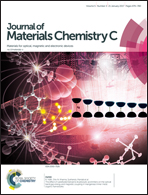Multi-substituted deep-blue emitting carbazoles: a comparative study on photophysical and electroluminescence characteristics†
Abstract
A series of carbazole derivatives containing various degrees of 2,3,6,7-substitutions with triphenylamine or carbazole chromophores have been synthesized by Suzuki–Miyaura coupling reaction in good yields and characterized by optical, electrochemical, thermal, theoretical and electroluminescence studies. The physicochemical properties of the dyes are significantly influenced by the linking topology and chromophore density around the central carbazole unit. The triphenylamine substituted derivatives showed red-shifted absorption/emission in the series attributable to their extended π-conjugation. Multiple substitutions on the carbazole core resulted in twisting of chromophores from the central carbazole and disturbed the effective inter-chromophoric electronic interactions, which led to shorter wavelength absorptions for tri- and tetra-substituted star-bursts when compared to di-substituted analogues. However, the starburst derivatives exhibited relatively high molar extinction coefficients attributable to the increased chromophore density. In contrast, the emission profiles of the starbursts are red-shifted when compared to triads. Also, the triphenylamine containing dyes displayed positive solvatochromism in emission attributable to the structural reorganization induced electronic perturbations. The solvatochromic data are suggestive of the general solvent effect in the excited state with some charge migration. Carbazole featuring dyes showed superior thermal stability over the triphenylamine derivatives due to the rigidity of the former chromophore. Electrochemical studies revealed comparatively high oxidation propensity for the triphenylamine-containing dyes and exhibited variations attributable to chromophore enrichment. Solution processable multilayer OLEDs were fabricated by employing these materials as emitting dopants in CBP which exhibited deep-blue electroluminescence with CIE coordinates, 0.16 ≤ x ≤ 0.17, 0.05 ≤ y ≤ 0.08. Interestingly, the linear di-substituted derivatives exhibited superior device performance over the tri- and tetra-substituted star-bursts attributable to the efficient trapping of excitons generated in the host matrix.



 Please wait while we load your content...
Please wait while we load your content...